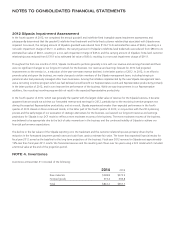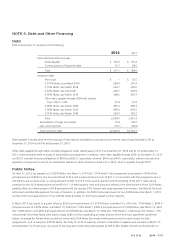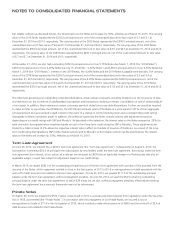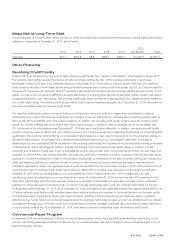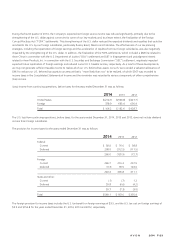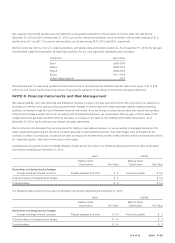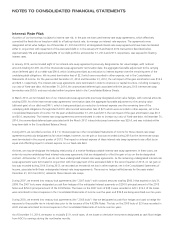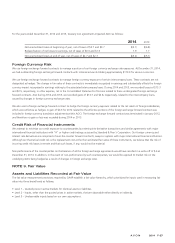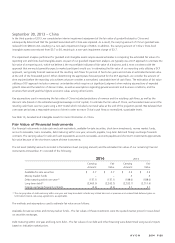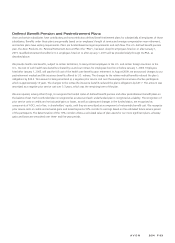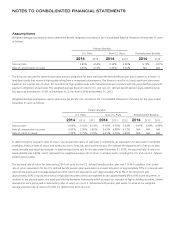Avon 2014 Annual Report Download - page 100
Download and view the complete annual report
Please find page 100 of the 2014 Avon annual report below. You can navigate through the pages in the report by either clicking on the pages listed below, or by using the keyword search tool below to find specific information within the annual report.NOTES TO CONSOLIDATED FINANCIAL STATEMENTS
Interest Rate Risk
A portion of our borrowings is subject to interest rate risk. In the past we have used interest-rate swap agreements, which effectively
converted the fixed rate on long-term debt to a floating interest rate, to manage our interest rate exposure. The agreements were
designated as fair value hedges. As of December 31, 2014 and 2013, all designated interest-rate swap agreements have been terminated
either in conjunction with repayment of the associated debt or in the January 2013 and March 2012 transactions described below.
Approximately 5% and approximately 8% of our debt portfolio at December 31, 2014 and 2013, respectively, was exposed to floating
interest rates.
In January 2013, we terminated eight of our interest-rate swap agreements previously designated as fair value hedges, with notional
amounts totaling $1,000. As of the interest-rate swap agreements’ termination date, the aggregate favorable adjustment to the carrying
value (deferred gain) of our debt was $90.4, which is being amortized as a reduction to interest expense over the remaining term of the
underlying debt obligations. We incurred termination fees of $2.3 which were recorded in other expense, net in the Consolidated
Statements of Income. For the years ended December 31, 2014 and December 31, 2013, the net impact of the gain amortization was $14.4
and $26.1, respectively. The interest-rate swap agreements were terminated in order to improve our capital structure, including increasing
our ratio of fixed-rate debt. At December 31, 2014, the unamortized deferred gain associated with the January 2013 interest-rate swap
termination was $50.0, and was included within long-term debt in the Consolidated Balance Sheets.
In March 2012, we terminated two of our interest-rate swap agreements previously designated as fair value hedges, with notional amounts
totaling $350. As of the interest-rate swap agreements’ termination date, the aggregate favorable adjustment to the carrying value
(deferred gain) of our debt was $46.1, which is being amortized as a reduction to interest expense over the remaining term of the
underlying debt obligations through March 2019. We incurred termination fees of $2.5 which were recorded in other expense, net in the
Consolidated Statements of Income. For the years ended December 31, 2014 and 2013, the net impact of the gain amortization was $6.3
and $6.0, respectively. The interest-rate swap agreements were terminated in order to increase our ratio of fixed-rate debt. At December 31,
2014, the unamortized deferred gain associated with the March 2012 interest-rate swap termination was $29.4, and was included within
long-term debt in the Consolidated Balance Sheets.
During 2013, we recorded a net loss of $.7 in interest expense in the Consolidated Statements of Income for these interest-rate swap
agreements previously designated as fair value hedges; however, no net gain or loss was recorded during 2014 as the interest-rate swaps
were terminated in the second quarter of 2013. The impact on interest expense of these interest-rate swap agreements was offset by an
equal and offsetting impact in interest expense on our fixed-rate debt.
At times, we may de-designate the hedging relationship of a receive-fixed/pay-variable interest-rate swap agreement. In these cases, we
enter into receive-variable/pay-fixed interest-rate swap agreements that are designated to offset the gain or loss on the de-designated
contract. At December 31, 2014, we do not have undesignated interest-rate swap agreements. As the remaining undesignated interest-rate
swap agreements were terminated in conjunction with the repayment of the associated debt in the second quarter of 2013, no net gain or
loss was recorded during 2014. During 2013, we recorded an immaterial net loss in other expense, net in the Consolidated Statements of
Income, associated with these undesignated interest-rate swap agreements. There was no hedge ineffectiveness for the years ended
December 31, 2013 and 2012, related to these interest-rate swaps.
During 2007, we entered into treasury lock agreements (the “2007 locks”) with notional amounts totaling $500.0 that expired on July 31,
2008. The 2007 locks were designated as cash flow hedges of the anticipated interest payments on $250.0 principal amount of the 2013
Notes and $250.0 principal amount of the 2018 Notes. The losses on the 2007 locks of $38.0 were recorded in AOCI. $19.2 of the losses
were amortized to interest expense in the Consolidated Statements of Income over five years and $18.8 are being amortized over ten years.
During 2003, we entered into treasury lock agreements (the “2003 locks”) that we designated as cash flow hedges and used to hedge the
exposure to the possible rise in interest rates prior to the issuance of the 4.625% Notes. The loss on the 2003 locks of $2.6 was recorded in
AOCI and was amortized to interest expense in the Consolidated Statements of Income over ten years.
As of December 31, 2014, we expect to reclassify $1.9, net of taxes, of net losses on derivative instruments designated as cash flow hedges
from AOCI to earnings during the next twelve months.


